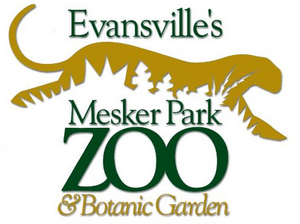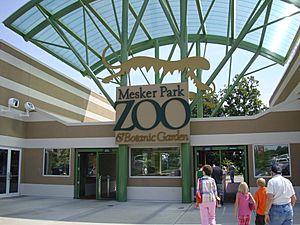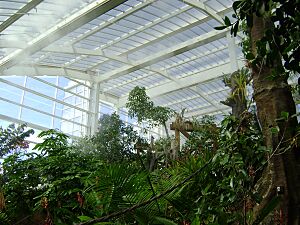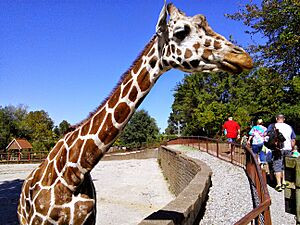Mesker Park Zoo and Botanic Garden facts for kids
 |
|

Zoo entrance
|
|
| Date opened | 1928 |
|---|---|
| Location | Evansville, Indiana, United States |
| Land area | 50 acres (20 ha) |
| Coordinates | 37°59′50″N 87°36′06″W / 37.9971°N 87.6016°W |
| No. of animals | 700+ |
| No. of species | 200 |
| Memberships | AZA |
| Major exhibits | African Rift, African Panorama, Amazonia, Australia, North America, and South America |
The Mesker Park Zoo and Botanic Garden is a fun zoo that opened in 1928 in Evansville, Indiana, United States. It's located in Mesker Park on the northwest side of Evansville. The City of Evansville helps run this amazing place.
This zoo is special because it's approved by the Association of Zoos and Aquariums (AZA). This means they meet high standards for animal care and conservation!
Contents
- A Look Back: Zoo History
- Explore the Amazing Exhibits
- Journey Through Amazonia
- North American Wildlife
- Discovery Center: Learning and Conservation
- Lemur Forest: Playful Primates
- African Rift: Giants of the Savanna
- Kley Building: Diverse Habitats
- Asia & Australia: From Rhinos to Kangaroos
- Children's Enchanted Forest: Fun for All Ages
- Lake Victoria: Peaceful Waters
- African Panorama: Wide Open Spaces
- Botanical Features: Plants of the Zoo
- More Fun: Attractions and Programs
- Conservation: Protecting Animals
A Look Back: Zoo History
The Mesker Park Zoo started way back in 1928. A group of local business leaders, including Gilmore M. Haynie, helped create it. A cartoonist named Karl Kae Knecht from the Evansville Courier & Press newspaper made the idea of a zoo very popular. When it first opened, the zoo had two lion cubs, some antelope, and an elephant.
New Additions and Big Changes
In 2008, the zoo finished a huge expansion. This included a $15 million tropical rainforest exhibit called Amazonia. They also built a new entry area for visitors. This new exhibit was very popular. More than 38,000 people visited in its first month! To make space for Amazonia, one of the zoo's two lakes was filled in. This new area added over 150 animals to the zoo.
In 2017, the zoo added the Engelbrecht Carousel. A year later, in 2018, a bird aviary was built right next to it. There used to be a carousel at the zoo a long time ago. This whole project cost about $3 million.
What's Next for the Zoo?
As of 2018, the zoo was planning a new outdoor penguin exhibit. By September 2019, signs at the zoo said the penguin exhibit was set to open in 2021. The zoo also hopes to update the African Rift area when they get enough funding.
Explore the Amazing Exhibits
Mesker Park was one of the first zoos in the United States to use a "moat system." This means they use moats instead of fences to display animals. It helps the exhibits look more natural!
Journey Through Amazonia
Amazonia is a fantastic rainforest exhibit that opened in 2008. It focuses on animals from Central and South America. While some structures look like plants, many of the plants you see are real living plants! The zoo's team takes care of them. This means the exhibit grows and changes over time. Plants are added, and sometimes trimmed, so sunlight can still get through.
This exhibit added over 150 animals to the zoo. You can see jaguars, Baird's tapirs, capybara, keel-billed toucans, bats, black howler monkeys, squirrel monkeys, prehensile-tailed porcupines, Arrau turtles, Cuvier's dwarf caiman, and many fish species from the Amazon River. The open spaces in Amazonia are also a free-flight bird aviary. Over ten different bird species fly freely here!
North American Wildlife
The North America exhibit features a large home for Mexican gray wolfes. You can also see prairie dogs and several types of birds of prey here.
Discovery Center: Learning and Conservation
The Discovery Center is an indoor and outdoor exhibit. It teaches visitors about conservation, education, and endangered species. This area also houses the zoo's education department. Many animals used in educational programs live here, though you might not always see them.
This exhibit is home to Francois' langurs, red pandas, clouded leopards, hyacinth macaws, and smaller reptile exhibits. A special part is the Hellbender exhibit. Here, the zoo keeps young eastern hellbenders. This is part of a statewide conservation program. They work with Purdue University and the Indiana Department of Natural Resources to help these salamanders.
Lemur Forest: Playful Primates
Lemur Forest opened in 1999. It was built to house the zoo's lemurs. Today, you can see three different species here: ring-tailed lemurs, red ruffed lemurs, and Coquerel's sifaka.
African Rift: Giants of the Savanna
The African Rift exhibit has large open areas. Here you can see reticulated giraffes, Grant's zebras, sitatunga, and white storks. In July 2018, the zoo welcomed a new 10-month-old giraffe named Clementine!
Kley Building: Diverse Habitats
The Kley Building was built in the 1950s and holds several exhibits. The upper floor has a nocturnal exhibit. This is where you can see animals that are active at night. There's also a reptile exhibit hall with rhinoceros iguanas and Komodo dragons. Another hall is used for traveling exhibits or special events.
The lower floor has the indoor part of the zoo's Indian rhinoceros exhibit. This floor used to be home to Bunny, an asian elephant. It also housed Donna, the world's oldest living hippopotamus in captivity. Donna was 60 years old when she passed away in 2012 due to her health.
Asia & Australia: From Rhinos to Kangaroos
This area creates habitats for animals from Asia and Australia. It includes the outdoor homes for the zoo's Indian rhinoceros. You can also see Bactrian camels, sarus cranes, barasingha, Amur tigers, Malayan sun bears, takin, kookaburras, and emus.
Children's Enchanted Forest: Fun for All Ages
This exhibit is made especially for children. It has playground elements and a seasonal petting zoo. You can also see traditional zoo animals here. It's home to North American river otters, colobus monkeys, binturongs, DeBrazza's monkeys, African crested porcupines, and macaws. Nearby, you'll find the Engelbrecht Carousel, a budgie aviary, a gibbon exhibit, and seasonal exhibits for tortoises.
Lake Victoria: Peaceful Waters
Lake Victoria is home to wild water birds and turtles. Visitors can walk all the way around this lake. You can also rent paddle boats to go out on the water. This is the biggest lake in the zoo. It's the main feature around which the zoo was first built.
African Panorama: Wide Open Spaces
African Panorama has several enclosures built around a large open African savanna exhibit. Visitors can look out over the main exhibit. Here you'll see Abyssinian ground-hornbills, ostriches, kudu, African crowned cranes, and springbok. Smaller exhibits feature a giant anteater, mara, and stanley crane.
Botanical Features: Plants of the Zoo
The Mesker Park Zoo is also a Botanic Garden! Besides the live plants inside Amazonia, the zoo grounds have many beautiful gardens. These are designed for visitors to enjoy. The zoo also grows special plants just for the animals to eat. Zookeepers harvest these plants all year long for the animals' diets.
Every February, many different orchids are displayed in the Amazonia exhibit. This is part of an event called Orchid Escape. In the spring, there's also a plant sale fundraiser. Guests can buy young plants that they've seen growing throughout the zoo.
More Fun: Attractions and Programs
Besides the new carousel, the zoo also has a playground, a cafe, and a gift shop. You can even ride a tram! The zoo offers many programs too. These include birthday parties, summer camps, and outreach programs. Teens and adults can also find volunteer opportunities here.
Conservation: Protecting Animals
Many animals at the zoo are part of breeding programs. These programs are organized by the AZA. The zoo follows recommendations to breed (or not breed) its animals. This helps protect endangered species. Some recent births at the zoo include Francois' langurs, sitatunga, takin, African crested porcupines, colobus monkeys, and lesser tenrecs.
Mesker Park Zoo is home to a pair of Mexican gray wolves. These animals are critically endangered. The zoo works with the United States Fish and Wildlife Service. They are part of a plan to help these wolves recover in the wild.
The zoo is also involved in helping eastern hellbenders. They partner with Purdue University and Indiana's Department of Natural Resources. Their goal is to help repopulate this type of salamander. The zoo has tanks where you can see young hellbenders. These young salamanders will be returned to their natural habitat once they are big enough to be safer from predators. The zoo also has an off-display area with adult salamanders that they hope will breed.




